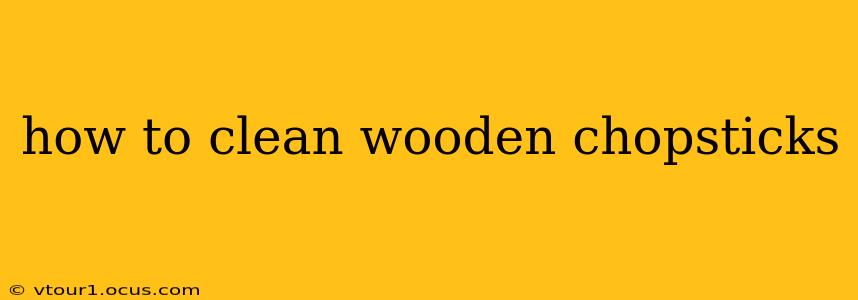Wooden chopsticks, with their elegant simplicity and eco-friendly nature, are a beloved utensil in many cultures. Proper cleaning is crucial not only for hygiene but also for extending the lifespan of your cherished chopsticks. This comprehensive guide will cover various cleaning methods, addressing common concerns and ensuring your chopsticks remain clean and sanitary.
How Often Should I Clean My Wooden Chopsticks?
This depends largely on usage. After every meal is ideal, especially if you're using them for oily or strongly flavored foods. If you only use them occasionally, a thorough cleaning after each use is still recommended.
What's the Best Way to Clean Wooden Chopsticks?
The most effective and gentle method is hand washing. Avoid putting wooden chopsticks in the dishwasher, as the high heat and harsh detergents can damage the wood, causing cracking, warping, and even leaching of chemicals into your food.
Here's a step-by-step guide to hand washing:
- Rinse: Immediately after use, rinse your chopsticks under warm, running water to remove any food particles.
- Wash: Use a mild dish soap and a soft sponge or brush. Gently scrub the chopsticks, paying attention to any crevices where food might be lodged. Avoid using abrasive cleaners or scouring pads that can scratch the surface.
- Rinse Thoroughly: Rinse the chopsticks again under running water to completely remove any soap residue.
- Dry: Pat the chopsticks dry with a clean, soft cloth or allow them to air dry completely. Air drying is preferable to prevent the wood from becoming damp and prone to mold. Store them in a dry, well-ventilated area.
Can I Soak Wooden Chopsticks?
Soaking wooden chopsticks for extended periods is generally discouraged. While a quick rinse is fine, prolonged soaking can cause the wood to absorb water, leading to warping, cracking, and the growth of mold or bacteria. If you have particularly stubborn food residue, a brief soak (no more than a few minutes) in warm, soapy water may be helpful, followed by thorough rinsing and drying.
How Do I Clean Sticky or Oily Chopsticks?
For chopsticks used with oily or sticky foods, a little extra attention is needed. You might find that a pre-rinse with hot water helps to loosen the residue before washing with soap and water. A soft-bristled brush can be particularly helpful in removing stubborn bits of food.
How Do I Sanitize Wooden Chopsticks?
While regular hand washing is usually sufficient, you can sanitize your chopsticks if you prefer. You can do this by briefly submerging them in boiling water for a few minutes. Ensure they are completely dry afterward to prevent mold growth. Alternatively, you can use a food-safe sanitizing solution, following the manufacturer's instructions carefully.
Are There Any Special Considerations for Different Types of Wooden Chopsticks?
Different woods have varying levels of porosity. Some might be more susceptible to absorbing water and damage than others. Generally, the cleaning methods described above work well for most types of wooden chopsticks. However, always refer to any care instructions provided by the manufacturer.
How Do I Store Wooden Chopsticks Properly?
Proper storage is key to maintaining the hygiene and longevity of your chopsticks. Store them in a clean, dry place, preferably in a dedicated chopstick holder or container. Avoid storing them in humid environments, as this can promote mold growth.
By following these simple yet effective cleaning and storage methods, you can ensure your wooden chopsticks remain clean, hygienic, and ready to grace your table for many meals to come. Remember that regular, gentle cleaning is the best way to prolong the life and beauty of your wooden chopsticks.
